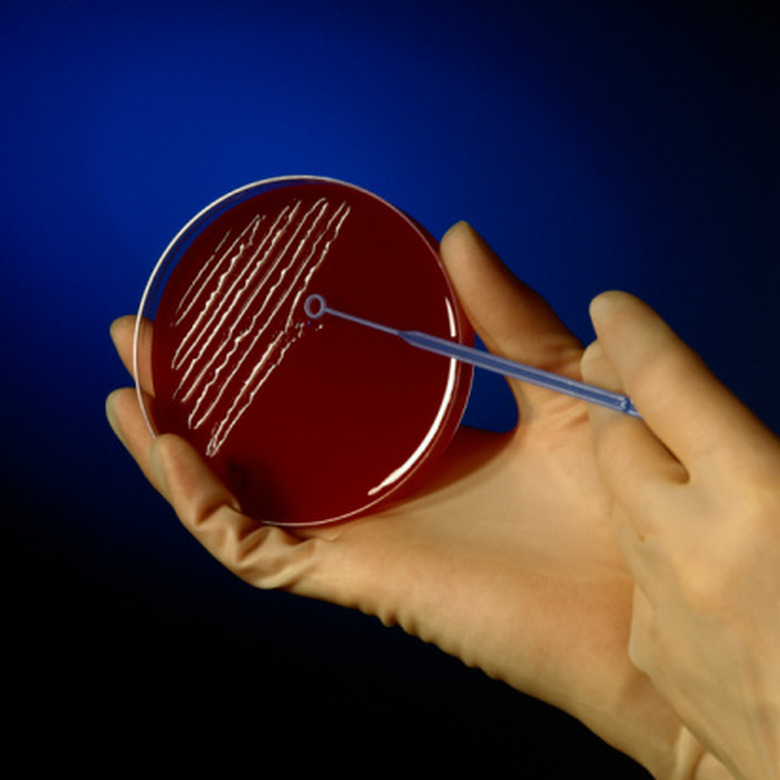How To Calculate The Amount Of Bacteria Present
Scientists use serial dilutions (a series of 1:10 dilutions) to calculate the population density of bacterial cultures. When a drop of culture containing a small number of bacteria is plated and incubated, each cell theoretically will be far enough away from other cells that it will form its own colony. (In reality, some colonies may be descendants of two nearby cells, but this is rare in dilute cultures, and so the number of colonies is a very good estimate of the number of cells originally transferred to the plate.) Because the population density is unknown, a variety of dilutions must be used in order to end up with one plate with an appropriate number of colonies.
Serial Dilutions
Step 1
Label the six test tubes (each containing 9 mL of growth media) as 1 through 6. Label the six agar plates as 1 through 6. Use a pipetter and sterile 1 milliliter (mL) pipette tips to transfer 1 mL of bacterial culture into tube 1.
Step 2
Mix well and transfer 1 mL from tube 1 into tube 2 using a pipetter and sterile 1 mL tips.
Step 3
Repeat Step 2 for the remaining tubes, each time transferring 1 mL from the most recently used tube to the next tube.
Step 4
Use a pipetter and sterile 0.1 mL tips to transfer 0.1 mL from tube 1 to an agar plate. Flame an L-shaped glass rod and use it to spread the drop evenly around the plate. Incubate the plate for 48 hours at an appropriate temperature for the bacteria being used. Different types of bacteria have different optimal growth temperatures. If you cannot find the optimal growth temperature using reference material, try incubating the plates at 25 and 37 degrees.
Step 5
Repeat Step 4, each time transferring liquid from a different test tube onto its corresponding plate.
Population Calculations
Step 1
Observe the six plates and choose the one with 30 to 200 isolated colonies.
Step 2
Multiply the number of colonies on the plate by 10 to calculate the number of cells per mL of culture from the dilution tube used.
Step 3
Multiply the number from Step 2 by 10^(plate number) to calculate the number of cells per mL of original culture. The value of 10^(plate number) is the dilution factor of the culture used to innoculate that plate.
Things Needed
- 6 test tubes
- 6 agar plates
- Bacterial culture
- Pipetter
- 0.1 mL and 1 mL sterile pipette tips
- Flame
- L-shaped glass rod
TL;DR (Too Long; Didn't Read)
Include all required nutrients in the agar plates. Auxotrophic bacteria require certain amino acids in addition to the basic media ingredients. Different auxotrophs have different nutrient requirements. Consult reference material to find out which amino acids, if any, your bacteria need.
Wait one second between flaming the glass rod and using it, so as not to burn the bacteria.
Warning
Always wear laboratory gloves when handling bacteria.
Cite This Article
MLA
Tutor, Sly. "How To Calculate The Amount Of Bacteria Present" sciencing.com, https://www.sciencing.com/calculate-amount-bacteria-present-8469410/. 24 April 2017.
APA
Tutor, Sly. (2017, April 24). How To Calculate The Amount Of Bacteria Present. sciencing.com. Retrieved from https://www.sciencing.com/calculate-amount-bacteria-present-8469410/
Chicago
Tutor, Sly. How To Calculate The Amount Of Bacteria Present last modified March 24, 2022. https://www.sciencing.com/calculate-amount-bacteria-present-8469410/
